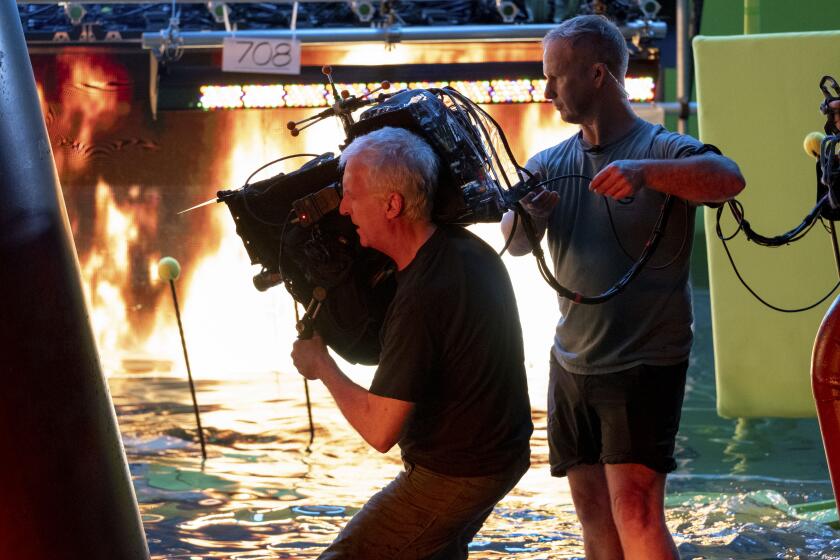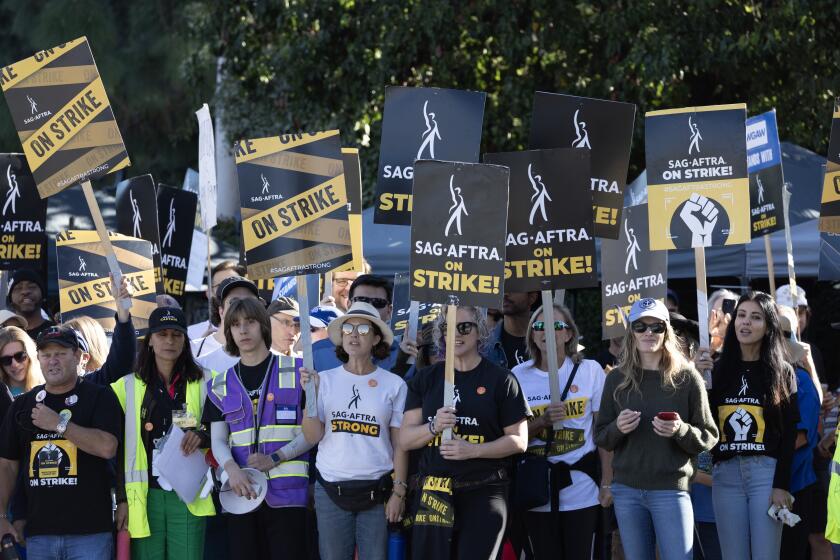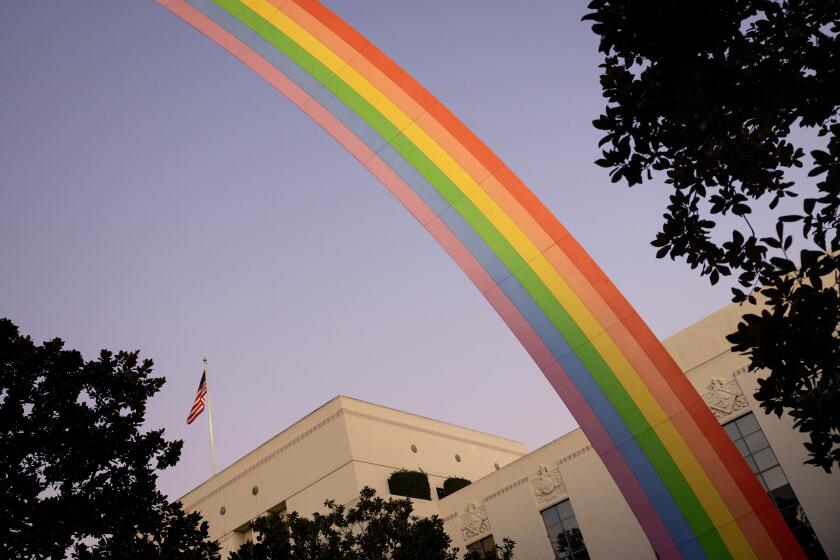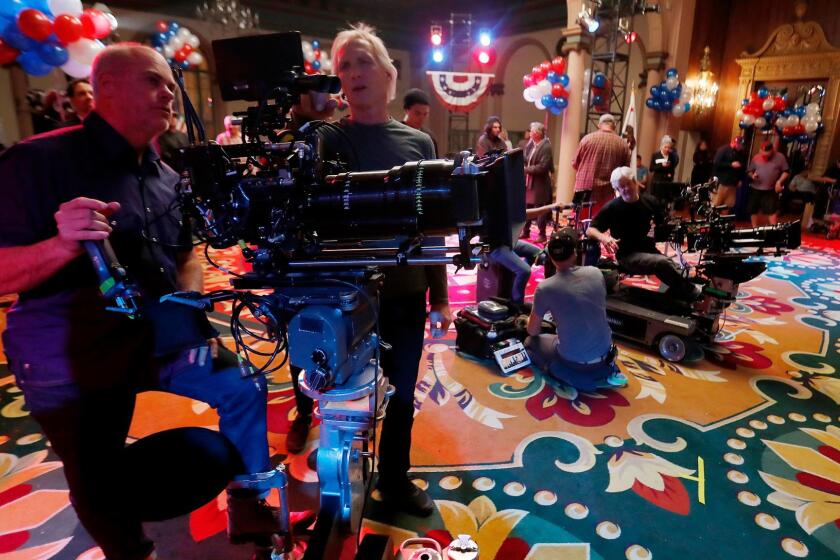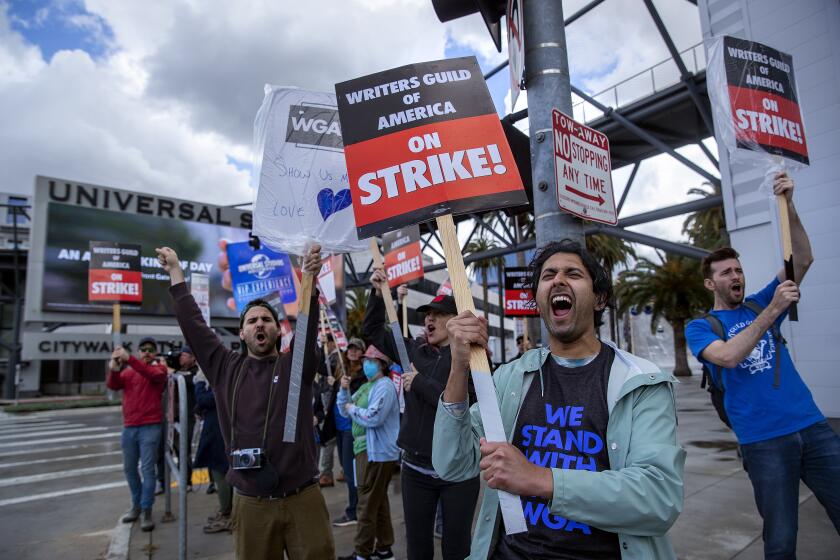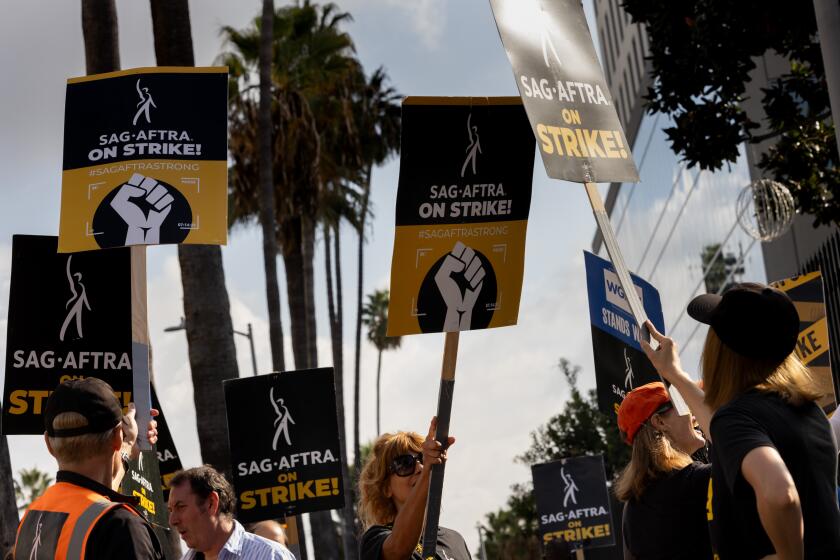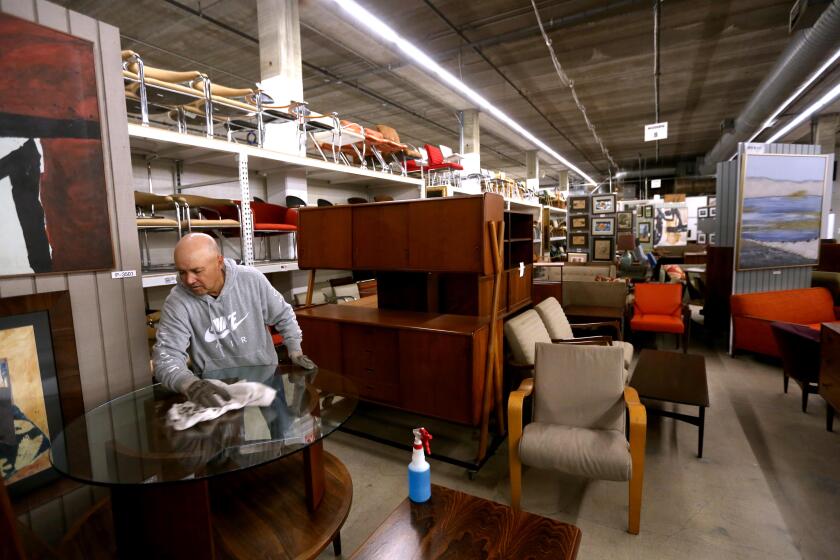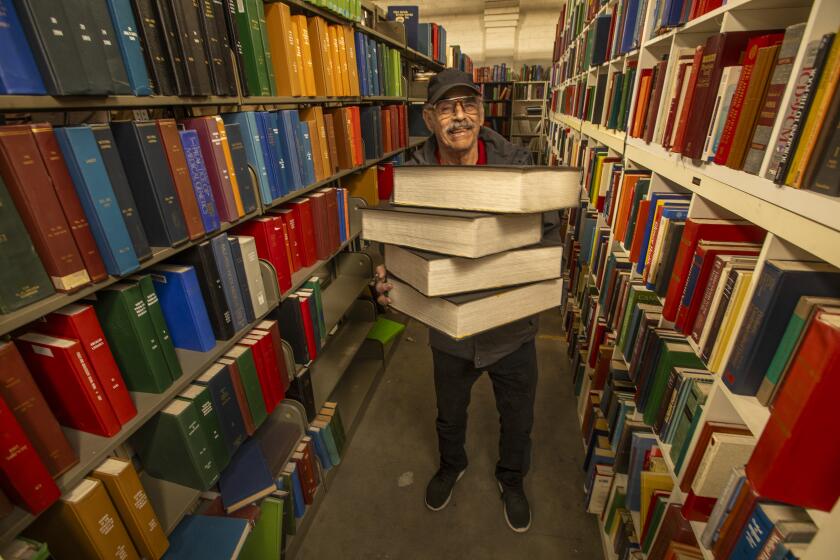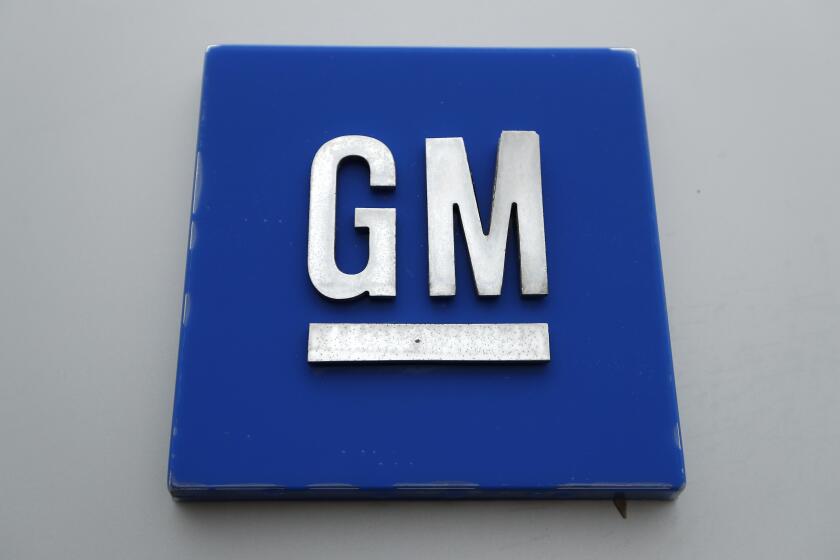Almost everyone in Hollywood wants to get back to work. What’s taking so long?
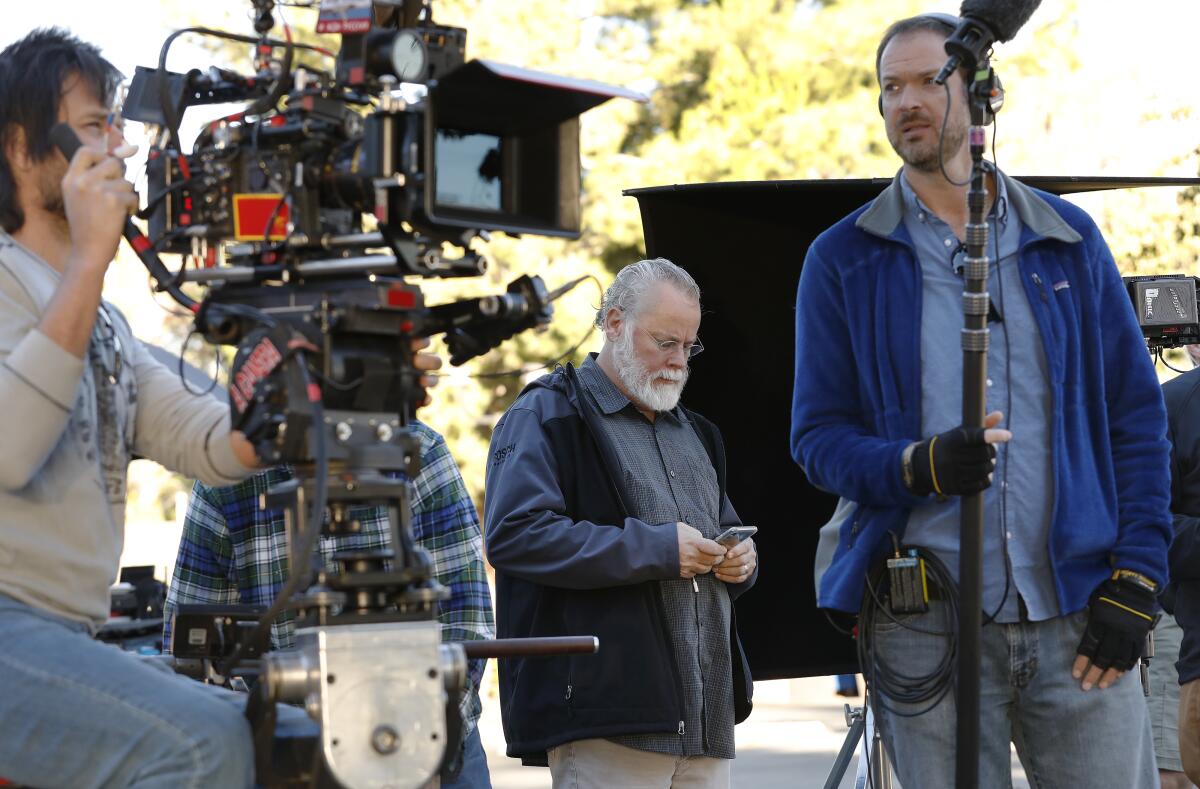
- Share via
After working nonstop on TV sets for almost all of 2022, unit production manager Matt Baker decided to take the rest of the year off. He looked forward to relaxing, playing golf and spending quality time with his wife and daughter. He expected to return to work after the holidays.
Things did not go as planned. Baker has not been employed on a film or TV set since October 2022.
“I was ... pretty keenly aware that we were going through a change in the industry, and there was going to be some consolidation, and I think the strikes had a lot of effect on how the studios were going to move forward,” said Baker, who has worked on TV series such as Hulu’s “Tiny Beautiful Things” and ABC’s “Modern Family.”
“It wasn’t going to be like gangbusters like it was in ’21 and ’22,” he added. “But I never in a million years thought that it would be this slow.”

Subscribers get exclusive access to this story
We’re offering L.A. Times subscribers special access to our best journalism. Thank you for your support.
Explore more Subscriber Exclusive content.
The Lake Balboa resident is far from the only entertainment professional in Los Angeles who has struggled to find work in the months prior to, during and following last year’s writers’ and actors’ strikes.
By the end of 2022, filming activity in the Greater Los Angeles area had already been on the decline, according to FilmLA, a nonprofit organization that tracks on-location shoot days and filming permits in the region. This downward trend was compounded by the overlapping work stoppages, which effectively shut down filming across the United States for six months.
Additionally, in the aftermath of the streaming wars — which saw several companies greenlight an excess of content in an effort to compete with Netflix — the studios have been tightening their belts, slashing their staffs, restructuring their businesses and slimming down their production budgets and slates.
The resulting lag poses a significant threat to California, where TV, film and commercial shoots are a sizable driver of employment supporting not just bigwig directors, producers and movie stars but also all the below-the-line laborers, craftspeople and myriad ancillary businesses that keep the industry moving.
“When there is a strike — when there’s a disruption — it affects a whole bunch of different areas that aren’t just simply Hollywood, ranging from tourism to food services to everything else,” said Kevin Klowden, executive director of MI finance at the Milken Institute. “Given that 40% of production employment is based in Southern California for the country ... that makes L.A. significantly more important and significantly more impacted when the entertainment industry has a problem.”
The last couple of years have seen a surge in filming, driven by pent-up demand after the pandemic forced a multi-month shutdown as well as streaming growth.
Worsening matters, California is finding it particularly hard to bounce back from the walkouts because it’s more expensive to shoot here, multiple production executives told The Times. That makes Los Angeles less attractive to studios looking to cut costs after major industry disruption.
“California — while it has its advantages — sits in the wrong place for a moment like this,” said one Hollywood producer who was not authorized to comment.
Once the Writers Guild of America and the Screen Actors Guild-American Federation of Television and Radio Artists resolved their labor disputes with the Alliance of Motion Picture and Television Producers, entertainment companies and workers alike seemed eager to turn the lights back on.
The major studios were desperate to salvage what they could of their 2024 film schedules, while creatives, performers and crew members couldn’t wait to get back on set and start making money again.
But filming did not rebound as quickly as many had hoped — at least, not in California.
Production levels in Los Angeles are down 36.4% compared with 2022, according to FilmLA, which attributed the drop to lingering effects of the strikes.
In January, the number of on-location shoot days in the Los Angeles area was down 26% from the same month in 2023. Meanwhile, the number of cast and crew members listed on permits during that time was down even more — about 30%, according to FilmLA.
FilmLA discovered that the unusual disconnect between permit numbers and employment occurred because most of those filming permits had been granted to smaller, independent projects, which tend to employ fewer cast and crew members than major studio and streaming productions. The top entertainment companies were not showing up to film in Los Angeles.
For example, of the 11 Universal Pictures films that have gone into production or preproduction since the strikes settled, none were shot or are set to shoot in California. Similarly, only one Warner Bros. feature — a new movie from “Licorice Pizza” writer-director Paul Thomas Anderson — out of seven has been filming in the Golden State. Nearly the same ratio applies to Sony, which has kick-started production on six movies, one of which is slated to shoot in California; Disney has 22 live-action films in various stages of production, roughly three of which are based in California.
The Otis College of Art and Design recorded a 17% employment drop in the entertainment industry in Los Angeles during the Hollywood strikes.
The decreasing volume of major motion pictures shooting in California continues a long-term pattern. Industry experts and insiders blamed the ongoing exodus on California’s tax credit system, which they said often struggles to compete with the programs of other popular filming locales, such as Georgia, New Mexico, New York, Louisiana and the United Kingdom.
The California Film Commission has been making efforts to prevent productions from fleeing to other parts of the country and overseas by offering film tax incentives. The state awards about $330 million annually to dozens of companies that shoot in state, but the tax incentives aren’t as generous as other destinations that vie for the same business.
In February, the state agency announced that it would bestow tax breaks on 15 upcoming local film productions. Five of those features were backed by major studio players, including Disney and Lucasfilm’s “The Mandalorian & Grogu,” which was awarded $21.8 million to film in California.
New legislation introduced Saturday would resolve Hollywood’s thorniest political fight in Sacramento
As other production hubs “continue to develop around the world, we have to find ways to be more competitive,” said FilmLA President Paul Audley. “Certainly, we aren’t being helped right now with a limited tax credit versus what others are doing around the world. And I frankly don’t anticipate that changing given what we’re hearing out of Sacramento at this point.”
The outlook for Los Angeles is better on the TV side. One of the industry’s most prolific TV studios, Warner Bros., has initiated production on about 20 shows since the strikes concluded, including 10 filming in California.
That’s a decent level of output stacked against 2023, but overall industry numbers pale in comparison to the great TV boom of 2021 and 2022. TV production activity in Los Angeles was still down during the first week of March by roughly 32% from two years ago, FilmLA found.
Hollywood’s twin strikes translated into a lost year of production for much of the industry with productions idle since last spring. SAG-AFTRA’s strike against major media companies stretched 118 days.
Many industry insiders pin the tepid recovery on an increasingly careful strategy on the studios’ part. One veteran TV executive, who was not authorized to comment, observed that traditional buyers are ordering fewer scripted shows, while studios and networks will ask for scripts and a TV show “bible” to evaluate the viability and story arc of a project before giving it the green light.
Another studio source noted a dearth of TV pilots circulating — which they said could be due to a backup of content caused by the production pause and a scarcity of scripts penned during the writers’ strike.
“I do not think the world of television — certainly original, scripted television — in our country will ever return to what it was in ’22,” said Travis Knox, an associate professor of producing at Chapman University. “It was 599 original scripted shows that year. We cannot sustain that. Eyeballs get spread way too thin, and you’re just not getting people tuning in because it’s too much content and not enough return.”
It was already late in the day and nearly 250 extras were still waiting patiently on set as the crew for the Amazon Studios series “Goliath” put the finishing touches on a scene with actor Billy Bob Thornton being shot at the Millennium Biltmore Hotel in downtown Los Angeles.
Several Los Angeles entertainment workers have said they began to register a noticeable drop in filming activity and employment opportunities around the end of 2022 and beginning of 2023.
“Leading up to the strikes ... a lot of us were already seeing those work opportunities disappear,” said Olivia Cain, a set medic based in North Hollywood who has worked on a number of films and TV series. “I was really holding my breath.”
In addition to feeling the economic ramifications of the Peak TV era, the studios were operating conservatively then under the looming threat of a writers’ strike, which came to pass in May, followed by the actors’ strike in July.
The 2023 WGA strike lasted 148 days, making it one of the longest work stoppages in Hollywood history. Why did it last so long?
Knox suspects a similar situation might be unfolding now in anticipation of a potential strike by the Hollywood crew members’ union, the International Alliance of Theatrical Stage Employees, whose contract with the AMPTP expires July 31. Although folks in Hollywood aren’t nearly as certain of an IATSE walkout as they were with the writers, Knox said entertainment companies may be playing it “overly cautious.”
A production executive at a major distributor who was not authorized to comment countered that there is still ample time to get a movie made between now and August, and it’s more likely that studios will take advantage of this window to get as many films in the can as possible before another potential work stoppage ensues.
“At this point last year, everybody was really, really nervous because they could see it coming,” Knox said. “Right now we’re still far enough away, and I think people are hoping that it’s gonna work out.”
Hollywood’s year of strikes has come to an end, but is a new one about to begin? Industry members reflect on the entertainment labor movement.
The sluggish rebound in the Southland has affected local prop houses, florists, marketing agencies, drivers, dry cleaners and the many other small businesses that rely on the buzz of steady Hollywood productions to pay their bills.
“It’s been sloooooooow,” said Mimi Clarke, vice president of Front Row Media, an entertainment marketing agency that represents brands doing product placement in movies. “January was a blip, February a bit more, March a bit more, but it’s not where it should be.”
These days, Clarke said, the agency — whose repertoire includes representing AOL in “You’ve Got Mail” — is getting about half as many inquiries per week as it got in late 2022. And a lot of the new outreach, she said, is for productions happening in other filming hot spots, such as Atlanta, Albuquerque and Croatia.
“L.A. is even quieter,” she said. “Not even half of what it should be.”
Los Angeles prop houses took a huge hit during the Hollywood writers’ and actors’ strikes. Now they’re preparing for the return of production.
Clarke, whose job entails spending time on the phone with people across the industry, said that in recent weeks she has heard a common thread: Producers are leery of launching projects that won’t wrap by the summer, when contracts representing more than 66,000 unionized Hollywood crew members are set to expire.
“The people who are striking are striking for good reason, but it’s hard,” she said. “It’s like Groundhog Day. Here we are again.”
Frank Uchalik, owner of laboratory and medical prop house Heritage Props LA, said that his business has been “actually very busy” in the wake of the writers’ and actors’ walkouts — which decimated his staff and prompted him to construct a hospital set he rented to nonunion productions in order to stay solvent.
Heritage now is bringing in around $150,000 a month, Uchalik said, and has built back to a staff of four. If the prop house stays this active, Uchalik expects to pay off the debt he incurred during the strikes within a couple of months.
“It’s just fortunate that a lot of the shows that did return — ‘The Rookie,’ ‘Station 19,’ ‘Grey’s Anatomy,’ ‘NCIS’ — they all happen to have a need for our product,” Uchalik said.
Longtime prop house owner Marc Meyer, widely considered a pioneer of the fake book, is fighting to save his ‘life’s work,’ Faux Library.
The prop house’s comeback offers a sliver of hope in an otherwise bleak moment for the hundreds of thousands of vendors, crew members, craftspeople and artists striving to make a living.
“Before the strikes, you really felt the production beating through the city,” Cain said. “The production trucks, the location signs, the massive pop-up tents, the camera equipment on the sidewalk — it was always all around you. ... And now, you don’t even want to ask your friends how they’re doing because you know exactly what the answer is. No one’s working. No one’s received a call.”
Times staff writer Meg James contributed to this report.
More to Read
Inside the business of entertainment
The Wide Shot brings you news, analysis and insights on everything from streaming wars to production — and what it all means for the future.
You may occasionally receive promotional content from the Los Angeles Times.
